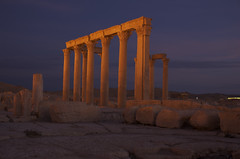Yesterday, I went to Tate Britain to see the "The Lure of the East", an exhibition of British orientalist painting. After my vacation in the Orient, I was excited to see how painters 150 years ago had seen the same area.
By the first two rooms, I was not disappointed. There were a few views of Damascus and glimpses into souks just like I had seen. Unfortunately, my initial delight was ruined, much like the cities on the canvasses were by centuries of marauding armies, by an increasingly madly screaming child. Why don't parents take their kids to the playground? The kids would enjoy it much more and the parents probably too, in the end.
As it was, with incessant wailing echoing through the hallowed halls of Tate, I ran to the exit and escaped into the main lobby, mercifully quiet. On my way out, my glance caught a painting of the Petra amphitheater, carved into rock for all eternity, that I wouldn't have missed even if I had driven by on a sports car in high gear. Out in the lobby, catching my breath among the distinguished crowd of Tate Britain-goers whose average age is significantly higher than that of Tate Modern regulars, I noticed how appropriate my precipitous retreat from the exhibition had been.
One floor up, a second exhibition comprised a set of runners who, one thirty seconds after the other, sprinted down all 86 meters of the Duveen Galleries. I went up to check it out but was less than impressed. Unless you actively wait for the action and stare down the central axis of the galleries to see the runner approach, you hardly notice what's going on. After all, we're not talking about a bejeweled lady in twelve-inch heels noisily clambering along. The sprinters in their trainers are hardly audible and are gone before a casual bystander even notices what's going on. If the point of the work was to contrast fast running with a still museum, it failed miserably.
I'm not sure that this was the point, though. Martin Creed was commissioned to make good use of the Duveen Galleries, and his first thought upon learning of the commission, according to an interview that is shown in one of the adjacent rooms, was to make runners sprint. In the same interview, he babbles about speed and velocity and fast and of running as being a symbol of speed and of fast as being the hallmark of life, whereas death is still, if you think about it. Throughout the five-minute loop, the guys comes about as particularly thick, as if he wasn't sure what his next word would be and why he had uttered the one before. It is hilarious.
Martin Creed is not a novice. In 2001, he won the Turner prize, the biggest award that can be bestowed upon a British artist, for his "Work No. 227, the lights going on and off", which was an empty room, painted white, where neon lights would go on and off every five seconds. It was by far the worst piece in a Turner prize retrospective that I saw last November and, if I was one of the guys winning the Turner prize afterwards, I would have probably rejected it on account of not wanting my art to be seen as just another set of lights turning on and off.
Anyway, I'm not an artist, and I'm not attacking Martin Creed for what he does. I think he's a genius for exposing the idiocy in the arts establishment and milking it for all it is worth. How much less can one do than putting a computer in a room that turns the lights on and off? Far from being the laughing stock of that year's exhibition, Work No. 227 won the big prize, as I mentioned, and Creed has arrived at Work No. 850 now, which, if you think about it, is nothing else than a variation of his biggest hit and could be called "Guy running down the hall on and off". Seven years of utter lack of progress, and the Tate loves him for that.
I shake my head and hold the firm opinion that what I have seen is no art at all. It's fine with me that my opinion isn't shared because I know that not all that's exhibited is art, and not all that's art is exhibited.

No comments:
Post a Comment